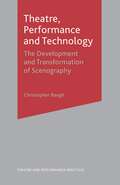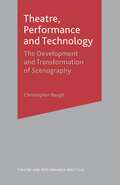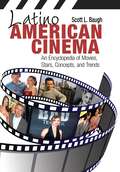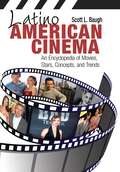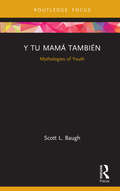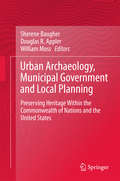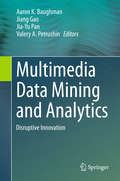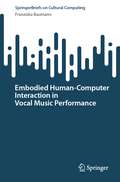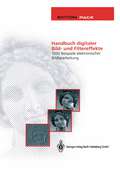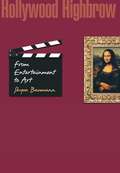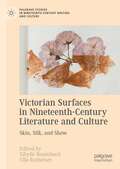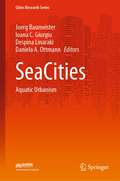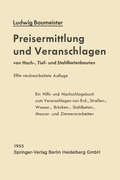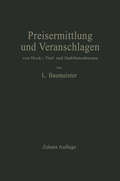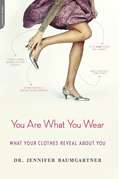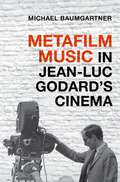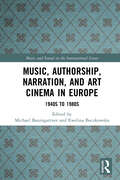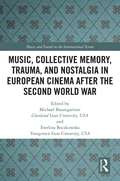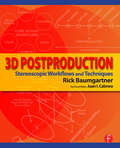- Table View
- List View
Theatre, Performance and Technology: The Development and Transformation of Scenography (Theatre and Performance Practices)
by Christopher BaughChris Baugh explores how developments and changes in technology have been reflected in scenography throughout history. Taking into account the latest research, his new edition examines moving light technologies, the internet as a platform of performance, urban scenography and how scenography has developed as a collaborative practice.
Theatre, Performance and Technology: The Development and Transformation of Scenography (Theatre and Performance Practices)
by Christopher BaughChris Baugh explores how developments and changes in technology have been reflected in scenography throughout history. Taking into account the latest research, his new edition examines moving light technologies, the internet as a platform of performance, urban scenography and how scenography has developed as a collaborative practice.Chris Baugh explores how developments and changes in technology have been reflected in scenography throughout history. Taking into account the latest research, his new edition examines moving light technologies, the internet as a platform of performance, urban scenography and how scenography has developed as a collaborative practice.
Latino American Cinema: An Encyclopedia of Movies, Stars, Concepts, and Trends
by Scott L. BaughLatino American cinema is a provocative, complex, and definitively American topic of study. This book examines key mainstream commercial films while also spotlighting often-underappreciated documentaries, avant-garde and experimental projects, independent productions, features and shorts, and more.Latino American Cinema: An Encyclopedia of Movies, Stars, Concepts, and Trends serves as an essential primary reference for students of the topic as well as an accessible resource for general readers. The alphabetized entries in the volume cover the key topics of this provocative and complex genre—films, filmmakers, star performers, concepts, and historical and burgeoning trends—alongside frequently overlooked and crucially ignored items of interest in Latino cinema. This comprehensive treatment bridges gaps between traditional approaches to U.S.-Latino and Latin American cinemas, placing subjects of Chicana and Chicano, Puerto Rican, Cuban and diasporic Cuban, and Mexican origin in perspective with related Central and South American and Caribbean elements. Many of the entries offer compact definitions, critical discussions, overviews, and analyses of star artists, media productions, and historical moments, while several foundational entries explicate concepts, making this single volume encyclopedia a critical guide as well.
Latino American Cinema: An Encyclopedia of Movies, Stars, Concepts, and Trends
by Scott L. BaughLatino American cinema is a provocative, complex, and definitively American topic of study. This book examines key mainstream commercial films while also spotlighting often-underappreciated documentaries, avant-garde and experimental projects, independent productions, features and shorts, and more.Latino American Cinema: An Encyclopedia of Movies, Stars, Concepts, and Trends serves as an essential primary reference for students of the topic as well as an accessible resource for general readers. The alphabetized entries in the volume cover the key topics of this provocative and complex genre—films, filmmakers, star performers, concepts, and historical and burgeoning trends—alongside frequently overlooked and crucially ignored items of interest in Latino cinema. This comprehensive treatment bridges gaps between traditional approaches to U.S.-Latino and Latin American cinemas, placing subjects of Chicana and Chicano, Puerto Rican, Cuban and diasporic Cuban, and Mexican origin in perspective with related Central and South American and Caribbean elements. Many of the entries offer compact definitions, critical discussions, overviews, and analyses of star artists, media productions, and historical moments, while several foundational entries explicate concepts, making this single volume encyclopedia a critical guide as well.
Y Tu Mamá También: Mythologies of Youth (Cinema and Youth Cultures)
by Scott L. BaughCharting production, distribution, censorship, and reception, this book examines Y Tu Mamá También in its presentation as a journey of self-discoveries. Three young adults enjoy a road trip together in search of a legendary beach. Behind their stories are mythologies of youth, a network of ideas in the film that reflects life outside the theaters. The deceptively complex film leaves the characters and its viewers with, instead of oversimplified and hollow answers, provocative questions and existential concerns. Made independently in Mexico, the film crosses over transnational issues, global markets, and mainstream and alternative aesthetics. It transforms road movie and youth film genres and shows a ‘musical, magical’ Mexico to the world. This book synthesizes several approaches in order to extensively examine Y Tu Mamá También. Covering the film’s production history, its distribution and censorship, and larger industrial, political, and cultural contexts, this book analyzes the too-often overlooked aspects of youthful sexuality alongside figurations of maturity, rites of passage, and covenants—made, broken, and remade—that not only inform representations of identity but also complicate the processes of identity formation themselves.
Y Tu Mamá También: Mythologies of Youth (Cinema and Youth Cultures)
by Scott L. BaughCharting production, distribution, censorship, and reception, this book examines Y Tu Mamá También in its presentation as a journey of self-discoveries. Three young adults enjoy a road trip together in search of a legendary beach. Behind their stories are mythologies of youth, a network of ideas in the film that reflects life outside the theaters. The deceptively complex film leaves the characters and its viewers with, instead of oversimplified and hollow answers, provocative questions and existential concerns. Made independently in Mexico, the film crosses over transnational issues, global markets, and mainstream and alternative aesthetics. It transforms road movie and youth film genres and shows a ‘musical, magical’ Mexico to the world. This book synthesizes several approaches in order to extensively examine Y Tu Mamá También. Covering the film’s production history, its distribution and censorship, and larger industrial, political, and cultural contexts, this book analyzes the too-often overlooked aspects of youthful sexuality alongside figurations of maturity, rites of passage, and covenants—made, broken, and remade—that not only inform representations of identity but also complicate the processes of identity formation themselves.
Urban Archaeology, Municipal Government and Local Planning: Preserving Heritage within the Commonwealth of Nations and the United States
by Sherene Baugher Douglas R. Appler William MossImproving the relationship between archaeology and local government represents one of the next great challenges facing archaeology –specifically archaeology done in urban settings. Not only does local government have access to powerful legal tools and policy mechanisms that can offer protection for privately owned archaeological sites, but because local government exists at the grassroots level, it is also often closer to people who have deep knowledge about the community itself, about its values, and about the local meaning of the sites most in need of protection. This partnership between archaeology and local government can also provide visibility and public programing for heritage sites. This book will explore the experiences, both positive and negative, of small and large cities globally. We have examined programs in the Commonwealth of Nations (formerly known as the British Commonwealth) and in the United States. These countries share similar perspectives on preservation and heritage, although the approaches these cities have taken to address municipal archaeology reveals considerable diversity. The case studies highlight how these innovative partnerships have developed, and explain how they function within local government. Engaging with the political sphere to advocate for and conduct archaeology requires creativity, flexibility, and the ability to develop collaborative partnerships. How these archaeological partnerships benefit the community is a vital part of the equation. Heritage and tourist benefits are discussed. Economic challenges during downturns in the economy are analyzed. The book also examines public outreach programs and the grassroots efforts to protect and preserve a community's archaeological heritage.
Multimedia Data Mining and Analytics: Disruptive Innovation
by Aaron K. Baughman Jiang Gao Jia-Yu Pan Valery A. PetrushinThis book provides fresh insights into the cutting edge of multimedia data mining, reflecting how the research focus has shifted towards networked social communities, mobile devices and sensors. The work describes how the history of multimedia data processing can be viewed as a sequence of disruptive innovations. Across the chapters, the discussion covers the practical frameworks, libraries, and open source software that enable the development of ground-breaking research into practical applications. Features: reviews how innovations in mobile, social, cognitive, cloud and organic based computing impacts upon the development of multimedia data mining; provides practical details on implementing the technology for solving real-world problems; includes chapters devoted to privacy issues in multimedia social environments and large-scale biometric data processing; covers content and concept based multimedia search and advanced algorithms for multimedia data representation, processing and visualization.
Embodied Human–Computer Interaction in Vocal Music Performance (Springer Series on Cultural Computing)
by Franziska BaumannThis SpringerBrief provides a unique insight into the practice and research of the connections between voice, HCI and embodiment. Specifically, it explores how the voice can be embodied and mediated by means of gestural communication through sensor interfaces and aims to situate and contextualise various aspects that generate meaningful connections in such interactive interface performance. The author offers an approach for understanding creative practices between humans and computers in gestural live music performance, from the perspective of the embodied relationships created within such systems. Underlying practices, principles and sensor technologies that support creativity in embodied human-computer interaction in vocal music performance are examined and a dynamic framework and tools for anyone wishing to engage with this subject in depth are presented. The book is essential reading not only for musicians, composers, researchers, application developers, musicologists and educators but also for students and tertiary institutions as well as actors and dramaturgs in a music context.
Handbuch digitaler Bild- und Filtereffekte: 1500 Beispiele elektronischer Bildbearbeitung (Edition PAGE)
by Hans D. BaumannWerbegrafiker, DTPler, Fotografen und alle, die Abbildungen und Illustrationen mit dem Computer herstellen, benutzen Mal- und Retuscheprogramme. Diese Programme enthalten eine große Zahl von Werkzeugen (Filter), mit deren Hilfe es möglich ist, Bilder und Fotos in unterschiedlichster Weise zu erzeugen, zu bearbeiten und zu verfremden, deren Anwendung jedoch umfangreiche Spezialkenntnisse voraussetzt. Das Buch erklärt anhand zahlreicher Illustrationen (teilweise farbig), wie diese Werkzeuge effektiv benutzt werden und welche Ergebnisse man mit welchen Einstellungen erhalten kann. Die Darstellung ist programmübergreifend. Dadurch ist es möglich, gezielt die gewünschten Effekte und Programme zu finden und anzuwenden. Für Macintosh und Windows!
Hollywood Highbrow: From Entertainment to Art
by Shyon BaumannToday's moviegoers and critics generally consider some Hollywood products--even some blockbusters--to be legitimate works of art. But during the first half century of motion pictures very few Americans would have thought to call an American movie "art." Up through the 1950s, American movies were regarded as a form of popular, even lower-class, entertainment. By the 1960s and 1970s, however, viewers were regularly judging Hollywood films by artistic criteria previously applied only to high art forms. In Hollywood Highbrow, Shyon Baumann for the first time tells how social and cultural forces radically changed the public's perceptions of American movies just as those forces were radically changing the movies themselves. The development in the United States of an appreciation of film as an art was, Baumann shows, the product of large changes in Hollywood and American society as a whole. With the postwar rise of television, American movie audiences shrank dramatically and Hollywood responded by appealing to richer and more educated viewers. Around the same time, European ideas about the director as artist, an easing of censorship, and the development of art-house cinemas, film festivals, and the academic field of film studies encouraged the idea that some American movies--and not just European ones--deserved to be considered art.
Hollywood Highbrow: From Entertainment to Art (PDF) (Princeton Studies in Cultural Sociology #30)
by Shyon BaumannToday's moviegoers and critics generally consider some Hollywood products--even some blockbusters--to be legitimate works of art. But during the first half century of motion pictures very few Americans would have thought to call an American movie "art." Up through the 1950s, American movies were regarded as a form of popular, even lower-class, entertainment. By the 1960s and 1970s, however, viewers were regularly judging Hollywood films by artistic criteria previously applied only to high art forms. In Hollywood Highbrow, Shyon Baumann for the first time tells how social and cultural forces radically changed the public's perceptions of American movies just as those forces were radically changing the movies themselves. The development in the United States of an appreciation of film as an art was, Baumann shows, the product of large changes in Hollywood and American society as a whole. With the postwar rise of television, American movie audiences shrank dramatically and Hollywood responded by appealing to richer and more educated viewers. Around the same time, European ideas about the director as artist, an easing of censorship, and the development of art-house cinemas, film festivals, and the academic field of film studies encouraged the idea that some American movies--and not just European ones--deserved to be considered art.
Victorian Surfaces in Nineteenth-Century Literature and Culture: Skin, Silk, and Show (Palgrave Studies in Nineteenth-Century Writing and Culture)
by Sibylle Baumbach Ulla RatheiserThis volume explores the politics and poetics of Victorian surfaces in their manifold manifestations. In so doing, it examines various cultural products ‘as they are’ and highlights the art of surface composition in the Victorian era as well as the socio-cultural ramifications of the preoccupation with the exterior. By closely reading the various surfaces materialising in Victorian literature and culture, the individual contributions explore the dialectics of surface and depth in Victorian (and Neo-Victorian) cultures as well as the legibility of surfaces. They look into the surfaces of literary narratives, paintings, and film but also into natural surfaces such as skin or bark. Each chapter foregrounds what is present rather than absent in a text, while also paying attention to the surfaces that become manifest on the diegetic level of the text, be they cloth, landscapes, or human bodies or faces.This is an open access book.
SeaCities: Aquatic Urbanism (Cities Research Series)
by Joerg Baumeister Ioana C. Giurgiu Despina Linaraki Daniela A. OttmannThis book highlights the research outcome of Cities Research Institute's SeaCities group at Griffith University and a panel with the same title which took place at the World Expo in Dubai 2021/22 supported by the UN. It reflects on topics which are relevant for a future aquatic urbanism like the evolution of a taxonomy for aquatic urbanism, island and ecological wetland development, the planning aspects of seascapes, as well as drivers for floating communities and aquacultural urbanism. The book broadens the perspective of the previous book "SeaCities: Urban Tactics for Sea-Level Rise" published in 2021 from a terrestrial towards an amphibious and aquatic understanding of future city development.
Preisermittlung und Veranschlagen von Hoch-, Tief- und Stahlbetonbauten: Ein Hilfs- und Nachschlagebuch zum Veranschlagen von Erd-, Straßen-, Wasser-, Brücken-, Stahlbeton-, Maurer- und Zimmererarbeiten
by Ludwig BaumeisterPreisermittlung und Veranschlagen von Hoch-, Tief- und Stahlbetonbauten: Ein Hilfs- und Nachschlagebuch zum Veranschlagen von Erd-, Straßen-, Wasser- und Brücken-, Stahlbeton-, Maurer- und Zimmerarbeiten
by Ludwig BaumeisterYou Are What You Wear: What Your Clothes Reveal About You
by Jennifer BaumgartnerMost every woman has found herself with a closet full of too many clothes or surrounded by brand-new items that somehow never get worn. Instead she gets stuck wearing the same few familiar pieces from a wardrobe that just doesn't feel "right." Dr. Jennifer Baumgartner argues that all those things are actually manifestations of deeper life issues.What if you could understand your appearance as a representation of your inner unresolved conflicts and then assemble a wardrobe to match the way you wish to be perceived? In this fashion guide that is like no other, Dr. Baumgartner helps readers identify the psychology behind their choices, so they can not only develop a personal style that suits their identity but also make positive changes in all areas of life.
You Are What You Wear: What Your Clothes Reveal About You
by Jennifer BaumgartnerMost every woman has found herself with a closet full of too many clothes or surrounded by brand-new items that somehow never get worn. Instead she gets stuck wearing the same few familiar pieces from a wardrobe that just doesn't feel "right." Dr. Jennifer Baumgartner argues that all those things are actually manifestations of deeper life issues.What if you could understand your appearance as a representation of your inner unresolved conflicts and then assemble a wardrobe to match the way you wish to be perceived? In this fashion guide that is like no other, Dr. Baumgartner helps readers identify the psychology behind their choices, so they can not only develop a personal style that suits their identity but also make positive changes in all areas of life.
Metafilm Music in Jean-Luc Godard's Cinema (Oxford Music / Media)
by Michael BaumgartnerHailed as a leading innovator of visual montage, unique storytelling style, and ground-breaking cinematography, Jean-Luc Godard is a prominent pioneer in sculpting complex soundtracks altering the familiar relationship between sound and image, but his achievements in sound have been largely overlooked. Such a lacuna in the extensive research on Godard's work is unfortunate, as Godard's lifelong preoccupation of exploring self-reflexively all aspects of filmmaking particularly affects film music. With the novel approach of metafilm music, extrapolated from Jean-Luc Godard's oeuvre, this book not only closes up a crucial gap in Godard research, but also offers detailed analyses of the music as metafilm music in Contempt, Alphaville, Band of Outsiders, Pierrot le fou, First Name: Carmen, Histoire(s) du cinéma, among other films and video productions. The innovative scholarly concept of metafilm music, enriching the burgeoning field of music in audio-visual media, describes how Godard thinks about film music with film music. This book thus provides a thorough examination of Godard's self-reflexive approach to film music which has resulted in a lifelong creation of multi-layered soundtracks pushing the envelope of film music and sound to the limit.
Metafilm Music in Jean-Luc Godard's Cinema (Oxford Music / Media)
by Michael BaumgartnerHailed as a leading innovator of visual montage, unique storytelling style, and ground-breaking cinematography, Jean-Luc Godard is a prominent pioneer in sculpting complex soundtracks altering the familiar relationship between sound and image, but his achievements in sound have been largely overlooked. Such a lacuna in the extensive research on Godard's work is unfortunate, as Godard's lifelong preoccupation of exploring self-reflexively all aspects of filmmaking particularly affects film music. With the novel approach of metafilm music, extrapolated from Jean-Luc Godard's oeuvre, this book not only closes up a crucial gap in Godard research, but also offers detailed analyses of the music as metafilm music in Contempt, Alphaville, Band of Outsiders, Pierrot le fou, First Name: Carmen, Histoire(s) du cinéma, among other films and video productions. The innovative scholarly concept of metafilm music, enriching the burgeoning field of music in audio-visual media, describes how Godard thinks about film music with film music. This book thus provides a thorough examination of Godard's self-reflexive approach to film music which has resulted in a lifelong creation of multi-layered soundtracks pushing the envelope of film music and sound to the limit.
Music, Authorship, Narration, and Art Cinema in Europe: 1940s to 1980s (Music and Sound on the International Screen)
by Michael Baumgartner Ewelina BoczkowskaMusic, Authorship, Narration, and Art Cinema in Europe: 1940s to 1980s investigates the function of music in European cinema after the Second World War up to the fall of the Berlin wall, a period when composers and directors embraced experimentation. Through analyses of music and sound in a wide range of iconic films from across Europe, the essays in this book provide a nuanced reconsideration of three core themes: auteur theory, art house film, and national cinema. Chapters written by an international array of contributors focus on case studies of music in the cinema of Carlos Saura, Jean-Pierre Melville, the Polish School, and Romanian directors, as well as collaborations between directors and composers, including Michelangelo Antonioni and Giovanni Fusco, Federico Fellini and Nino Rota, Leo Arnshtam and Dmitry Shostakovich, and Peter Greenaway and Michael Nyman. The contributors shift the emphasis from a director-centered view to the working relationship between director and composer, and from the visual component to the sonic aspects of these films, without ignoring the close correlation between soundtrack and visual elements. Enriching our understanding of the complex, intertwined nature of authorship in film, the role of film music, and sound, nation-state and art cinema, and European cinematic history, this volume offers a valuable addition to research across music and film studies.
Music, Authorship, Narration, and Art Cinema in Europe: 1940s to 1980s (Music and Sound on the International Screen)
by Michael Baumgartner Ewelina BoczkowskaMusic, Authorship, Narration, and Art Cinema in Europe: 1940s to 1980s investigates the function of music in European cinema after the Second World War up to the fall of the Berlin wall, a period when composers and directors embraced experimentation. Through analyses of music and sound in a wide range of iconic films from across Europe, the essays in this book provide a nuanced reconsideration of three core themes: auteur theory, art house film, and national cinema. Chapters written by an international array of contributors focus on case studies of music in the cinema of Carlos Saura, Jean-Pierre Melville, the Polish School, and Romanian directors, as well as collaborations between directors and composers, including Michelangelo Antonioni and Giovanni Fusco, Federico Fellini and Nino Rota, Leo Arnshtam and Dmitry Shostakovich, and Peter Greenaway and Michael Nyman. The contributors shift the emphasis from a director-centered view to the working relationship between director and composer, and from the visual component to the sonic aspects of these films, without ignoring the close correlation between soundtrack and visual elements. Enriching our understanding of the complex, intertwined nature of authorship in film, the role of film music, and sound, nation-state and art cinema, and European cinematic history, this volume offers a valuable addition to research across music and film studies.
Music, Collective Memory, Trauma, and Nostalgia in European Cinema after the Second World War (Music and Sound on the International Screen)
by Michael Baumgartner Ewelina BoczkowskaIn the wake of World War II, the arts and culture of Europe became a site where the devastating events of the 20th century were remembered and understood. Exploring one of the most integral elements of the cinematic experience—music—the essays in this volume consider the numerous ways in which post-war European cinema dealt with memory, trauma and nostalgia, showing how the music of these films shaped the representation of the past. The contributors consider films from the United Kingdom, Poland, the Soviet Union, France, Italy, Germany, Sweden, Austria, and the Netherlands, providing a diverse and well-rounded understanding of film music in the context of historical memory. Memory is often underrepresented within scholarly musical studies, with most of these applications found in the disciplines of ethnomusicology, popular music studies, music cognition, and psychology and music therapy. Likewise, trauma has mainly been studied in relation to music in only a few historical contexts, while nostalgia has attracted even less academic attention. In three parts, this volume addresses each area of study as it relates to the music of European cinema from 1945 to 1989, applying an interdisciplinary approach to investigate how films use music to negotiate the precarious relationships we maintain with the past. Music, Collective Memory, Trauma, and Nostalgia in European Cinema after the Second World War offers compelling arguments as to what makes music such a powerful medium for memory, trauma and nostalgia.
Music, Collective Memory, Trauma, and Nostalgia in European Cinema after the Second World War (Music and Sound on the International Screen)
by Michael Baumgartner Ewelina BoczkowskaIn the wake of World War II, the arts and culture of Europe became a site where the devastating events of the 20th century were remembered and understood. Exploring one of the most integral elements of the cinematic experience—music—the essays in this volume consider the numerous ways in which post-war European cinema dealt with memory, trauma and nostalgia, showing how the music of these films shaped the representation of the past. The contributors consider films from the United Kingdom, Poland, the Soviet Union, France, Italy, Germany, Sweden, Austria, and the Netherlands, providing a diverse and well-rounded understanding of film music in the context of historical memory. Memory is often underrepresented within scholarly musical studies, with most of these applications found in the disciplines of ethnomusicology, popular music studies, music cognition, and psychology and music therapy. Likewise, trauma has mainly been studied in relation to music in only a few historical contexts, while nostalgia has attracted even less academic attention. In three parts, this volume addresses each area of study as it relates to the music of European cinema from 1945 to 1989, applying an interdisciplinary approach to investigate how films use music to negotiate the precarious relationships we maintain with the past. Music, Collective Memory, Trauma, and Nostalgia in European Cinema after the Second World War offers compelling arguments as to what makes music such a powerful medium for memory, trauma and nostalgia.
3D Postproduction: Stereoscopic Workflows and Techniques
by Rick BaumgartnerMaster the complex realities of 3D postproduction workflows and solutions with this one-of-a-kind guide. Brimming with techniques that have been used on actual 3D productions and can easily be incorporated into your own workflows, Rick Baumgartner’s 3D Postproduction offers you: The best practices for 3D preproduction and production to ensure a smooth post process, saving both time and money Abundant workflow diagrams, screen grabs, and checklists to reinforce your learning with visual cues Common postproduction considerations such as dailies, assembly, cutting, and color correction, and how they differ between 3D and 2D post pipelines Examples of 3D gone bad and how those scenarios can be avoided In-depth interviews with working professionals and extensive tutorials that provide practical insight from the trenches of real-world 3D postproduction A companion website (www.focalpress.com/cw/baumgartner) featuring project files and video clips demonstrating the 3D workflows covered in the book An effective 3D postproduction workflow allows for easier and more flexible editing, greater capacity for visual effects enhancement, the ability to fix production mistakes, and much more. You can’t afford to miss out! Bring your 3D projects to the next level with 3D Postproduction: Stereoscopic Workflows and Techniques.
